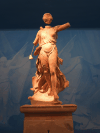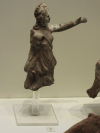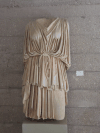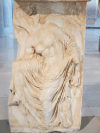
Temple of Athena Nike in the Acropolis, Athens, Greece (420 BCE). (723k)
From the Nike (mythology) entry in Wikipedia:
In Greek mythology, Nike was a goddess who personified victory in any field including art, music, war, and athletics. She is often portrayed in Greek art as Winged Victory in the motion of flight; however, she can also appear without wings as "Wingless Victory" when she is being portrayed as an attribute of another deity such as Athena. In Greek literature Nike is described as both an attribute and attendant to the gods Zeus and Athena. Nike gained this honored role beside Zeus during the Titanomachy where she was one of the first gods to offer her allegiance to Zeus. At Athens, Nike became a servant to Athena as well as an attribute of her due to the prominent status Athena held in her patron city. The fusion of the two goddesses at Athens has contributed to the ambiguity surrounding Nike's origins. It is unclear whether she originated from a character trait of the Greek goddess Athena or has always existed as an independent deity. Her origin story in Greek mythology is also slightly ambiguous, with the Theogony claiming Nike to be the daughter of Styx and Pallas while the Homeric Hymns describe Ares as being Nike's father. Her Roman equivalent was Victoria.
All pictures are © Dr. Günther Eichhorn, unless otherwise noted.
Goddess of victory.
Nike is often portrayed in literature in close association with Zeus or Athena. She is typically described as either an attendant of the Greek Gods Zeus and Athena or as a facet of their personalities. According to the Theogony Nike, Zelus, Kratos, and Bia "...will not live apart from Zeus... nor go except where the god goes before them, but they sit for ever beside heavy-booming Zeus." Nike and her siblings achieved these honorable positions by Zeus's side during the Titanomachy. During the war with the Titans Zeus called all the gods to Olympus to determine their allegiance. He declared that any god that chose to align with him against Kronos would receive his honor and favor. Of the gods, Styx and her children were the first to declare their loyalty to Zeus and as a result Zeus granted her and her children his favor. For Styx he gave her the honor of being "...the great oath of the gods..." For her children Zeus granted them his eternal favor by allowing them "...to dwell with him for all time." As a result, Nike is often portrayed in literature in association with Zeus since she holds an honorable position by his side: "Victory... in golden Olympus, standing beside Zeus..."
In Nonnos' Dionysiaca, Nike is described as an emissary of Athena who was sent to aid Zeus in his battle against Typhon. When the many snake-headed giant Typhon laid siege to Olympus in the final days of the Titanomachy, Nike reproached Zeus for his hesitancy in confronting Typhon and urged him to gather his thunderbolts in preparation to defend Olympus. In her speech she mentions all the gods that have given up and fled the battle including Ares, Hermes, Apollo, Aphrodite, and Hephaistos. She also mentions the possible repercussions of allowing Typhon to win, which includes the destruction of Olympus and the rape and enslavement Zeus's daughters Athena and Artemis. When in the morning Typhon again issued his challenge, Zeus gathered the clouds around himself for armor and answered the monster's threats. Nike, described as Victory, led Zeus into battle as Eris, Strife, led Typhon. During the fighting Nike used her shield to protect Zeus while he fought with his thunderbolts and frigid rain. By assaulting Typhon with fire and ice, Zeus was able to defeat the monster and claim victory over the Titans. As Zeus rode off from the battlefield, Nike followed him driving her father's chariot. In the Theogony, this battle is described in a different manner. Zeus is neither hesitant nor fearful and Nike makes no appearance to encourage or aid Zeus in the fighting.
Nike is also depicted in literature as a goddess who judges the excellence of gods and mortals in competition. This role of assessing the greatness of skill of a god or mortal is most evident in war, where Nike is often depicted on the side of the victor granting them the victory. An example if this is in Ovid's Metamorphoses book 8 where the fate of the war between Megara and Crete hung in "...suspense; so, Victory day by day between them hovered on uncertain wings." However, Nike's role of judging excellence is not limited to strictly military prowess. Instead, Nike observes victory in any field including musical, athletic, and or military competitions. For instance in Pindar Nemean 5, the victorious athlete Euthymenes of Aegina has "twice fallen into the arms of Victory" and achieved fame. In Bacchylides Ode 12 Nike encourages Teisias of Aegina to compete in the wrestling matches at Nemea. In both these examples Nike is associated with victory in an athletic competition rather than only a military competition. Typically, Nike is the one who bestows the victor with the prize. In Bacchylides Ode 11 she is introduced with the stock epithet "giver of swift gifts..." However, Nike is also represented in some sources as the prize in a contest to symbolize victory: "... the blossoms of glory-bringing Victory nurture for men golden, conspicuous fame throughout their lives..." In this source Nike is portrayed as a garland of flowers to be bestowed upon the victor during the Panhellenic Games.





This page contains 5 pictures
Here are the links to the other main pages on Greece:
Page last updated on Fri Aug 19 17:03:50 2022 (Mountain Standard Time)
Nike on soaring.guenther-eichhorn.com